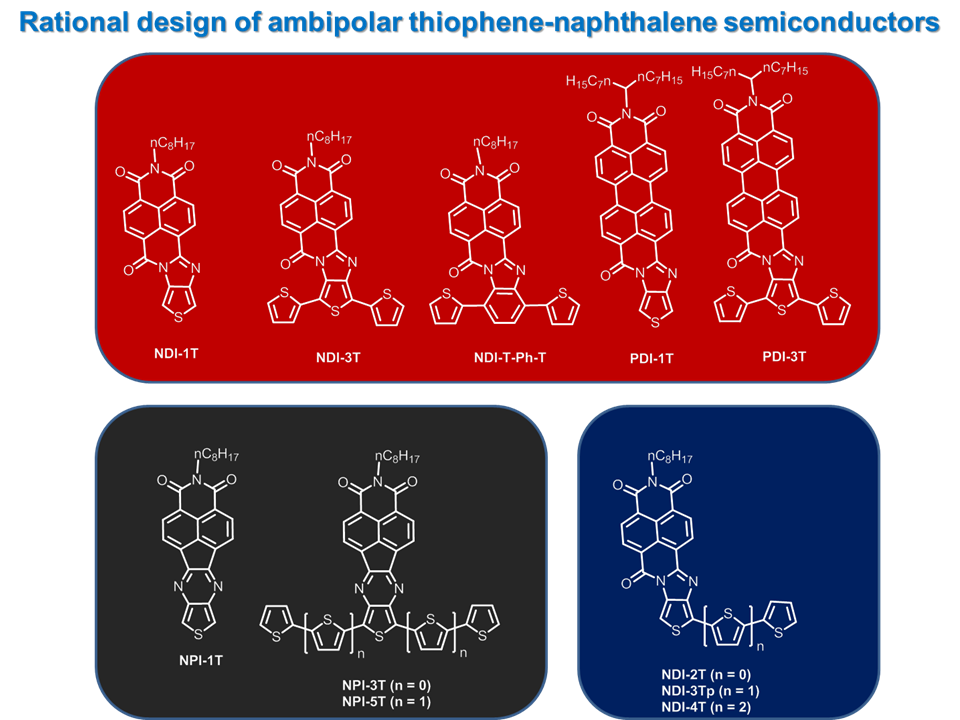Materials for (Opto)electronic devices
Organic semiconductors have attracted interest for diverse optoelectronic applications because of their potential in lowcost, large-area, and flexible electronic devices. New materials with high field-effect mobilities above 10 cm2V-1s-1 and recently established sophisticated solution-processing techniques for single-crystalline devices have encouraged the active development of new organic semiconductors.
In our group we are active in the development of ambipolar organic materials and in the study of the interplay of different effects on organic thin film transistors device response characteristics including (i) the influence of oligothiophene backbone elongation, (ii) the influence of the introduction of different amounts of naphthalimide moieties and (iii) effect of molecular dipole moments on OFET performance. Novel systems are characterised by cyclic voltammetry (CV), UV-vis absorption, Raman spectroscopy, and density functional theory (DFT) calculations. In addition, their electrical properties in OFETs are examined using solution-processed films.

Publications:
- Small asymmetric halogenated Phenylene–Naphthalimide molecules for organic field-effect transistors, Dyes & Pigments, 242, 112984 (2025)
- Electrochromic and Supercapacitive Capabilities of Naphthalene Amidine Monoimide Terthiophene n−p Dopable Electropolymer, ACS Electrochemistry, 1(6), 860 (2025)
- Low-bandgap oligothiophene-naphthalimide oligomeric semiconductors for thermoelectric applications, J. Mater. Chem. C 13, 6922-6932 (2025)
-
High-Throughput Screening of Low-Bandgap Organic
Semiconductors for Photovoltaic Applications: In the
Search of Correlations, Sol. RRL 2400213 (2024) -
Tuning the charge stabilization and transport in naphthalimide-based semiconductors via fused-ring and coreengineering strategy, Mater. Chem. Front. 8, 1981 (2024)
-
Tailoring the Electron-Deficient Central Core on Fused-Ring Nonfullerene Acceptors: Deciphering the Relationships Between Structure, Property, And Photovoltaic Performance, Adv. Energy Sustainability Res. 2400028 (2024)
- Tunable electroactive oligothiophenenaphthalimide semiconductors via end-capped engineering: cumulative effects beyond the linker, J. Mater. Chem. C, 11, 10852 (2023)
- Comparing the microstructure and photovoltaic performance of 3 perylene imide acceptors with similar energy levels but different packing
tendencies J. Mater. Chem. C, 10, 1698 (2022) - Oligothiophene-Naphthalimide Hybrids Connected through Rigid and Conjugated Linkers in Organic Electronics: An Overview, Mater. 2, 222 (2021).
- Synthesis and electronic properties of nitrogen-doped p-extended polycyclic aromatic dicarboximides with multiple redox processes, J. Mater. Chem. C, 9, 7936 (2021)
- Effective interplay of donor and acceptor groups for tuning optoelectronic properties in oligothiophene–naphthalimide assemblies, Mater. Chem. C, 8, 15277 (2020).
- Even and odd oligothiophene-bridged bis-naphthalimides for n-type and ambipolar organic field effect transistors, J. Mater. Chem. C, 5, 9439 (2017).
- Molecular aggregation of naphthalimide organic semiconductors assisted by amphiphilic and lipophilic interactions: a joint theoretical and experimental study, Chem.Chem.Phys., 19, 6206 (2017).
- Benzotrithiophene vs. Benzo/Naphtha-dithiophene Building Blocks: The effect of star-shaped versus linear conjugation on their electronic structures Chem. Eur. J. (2016)
- Singular Temperatures Connected to Charge Transport Mechanism Transitions in Perylene Bisimides from Steady-State Photocurrent Measurements J. Phys. Chem. C 119, 14023 (2015)
- The unusual electronic structure of ambipolar dicyanovinyl-substituted diketopyrrolopyrrole derivatives J. Mater. Chem. C 2, 6376 (2014)
- Molecular and Electronic-Structure Basis of the Ambipolar Behavior of Naphthalimide–Terthiophene Derivatives: Implementation in Organic Field-Effect Transistors, Chem. Eur. J. 19, 12458 (2013)
- Rational Design of Ambipolar Organic Semiconductors: Is Core Planarity Central to Ambipolarity in Thiophene–Naphthalene Semiconductors? Chem. Eur. J., 18, 532 (2012)
- Highly efficient solution-processed white organic light-amitting diodes based on novel copolymer single layerSynth. Met. 161, 2580 (2012)
- Organic n-Channel Field-Effect Transistors Based on Arylenediimide-Thiophene Derivatives, J. Am. Chem. Soc., 132, 8440 (2010)
- Synthesis and tunable emission of novel polyfluorene co-polymers with 1,8-naphthalimide pendant groups and application in a single layer-single component white emitting device, Eur. Polym. J., 46, 1778 (2010)
- On the blue emission of a novel solution processed stilbenoid dendrimer in thin film for OLEDs displays. Journal of Luminescence 128, 761 (2008)
- Plastic Solar Cells: A Multidisciplinary Field to Construct Chemical Concepts from Current Research. J. Chem. Educ. 84, 253(2007)
- Materials for Organic Solar Cells. The C60 / p-Conjugated Oligomer Approach. Chem. Soc. Rev. 34, 31 (2005)
- Design, Synthesis and Photovoltaic Properties of [60]Fullerene Based Molecular Materials. Mat. Sci. Eng. C. 25, 835 (2005)
- Polymer solar cells with novel fullerene-based acceptor. Thin Solid Films., 451, 43 (2004)
- Photophysical Properties and Optoelectronic Device Applications of a Novel Naphthalene Vinylene Type Conjugated Polymer. J. Phys. Chem. B, 105, 4099 (2001)
